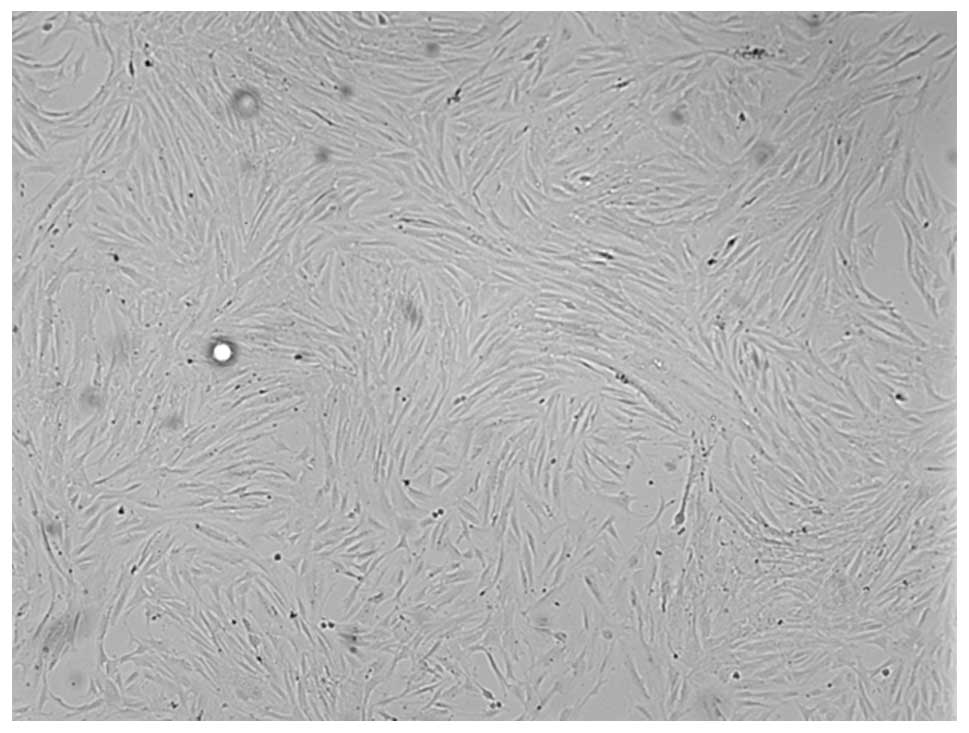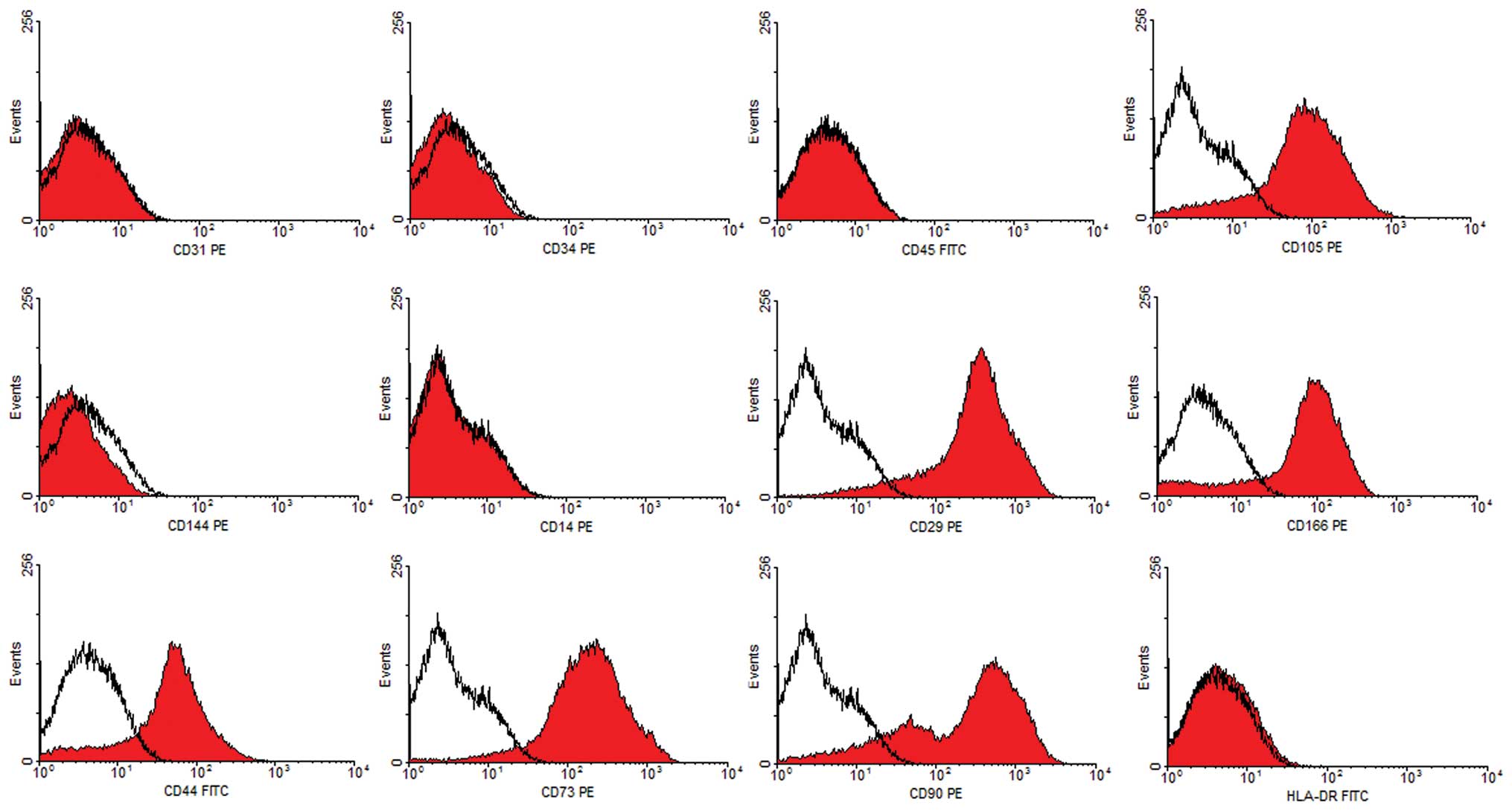|
1
|
Lim SD, Stallcup W, Lefkove B,
Govindarajan B, Au KS, Northrup H, et al: Expression of the neural
stem cell markers NG2 and L1 in human angiomyolipoma: are
angiomyolipomas neoplasms of stem cells? Mol Med. 13:160–165.
2007.PubMed/NCBI
|
|
2
|
Bonetti F, Pea M, Martignoni G, Doglioni
C, Zamboni G, Capelli P, et al: Clear cell (‘sugar’) tumor of the
lung is a lesion strictly related to angiomyolipoma - the concept
of a family of lesions characterized by the presence of the
perivascular epithelioid cells (PEC). Pathology. 26:230–236.
1994.
|
|
3
|
Barnard M and Lajoie G: Angiomyolipoma:
immunohistochemical and ultrastructural study of 14 cases.
Ultrastruct Pathol. 25:21–29. 2001. View Article : Google Scholar : PubMed/NCBI
|
|
4
|
Cao H, Xu W, Qian H, Zhu W, Yan Y, Zhou H,
et al: Mesenchymal stem cell-like cells derived from human gastric
cancer tissues. Cancer Lett. 274:61–71. 2009. View Article : Google Scholar : PubMed/NCBI
|
|
5
|
Bussolati B, Bruno S, Grange C, Ferrando U
and Camussi G: Identification of a tumor-initiating stem cell
population in human renal carcinomas. FASEB J. 22:3696–3705. 2008.
View Article : Google Scholar : PubMed/NCBI
|
|
6
|
Gupta S, Verfaillie C, Chmielewski D, Kren
S, Eidman K, Connaire J, et al: Isolation and characterization of
kidney-derived stem cells. J Am Soc Nephrol. 17:3028–3040. 2006.
View Article : Google Scholar : PubMed/NCBI
|
|
7
|
da Silva Meirelles L, Chagastelles PC and
Nardi NB: Mesenchymal stem cells reside in virtually all post-natal
organs and tissues. J Cell Sci. 119:2204–2213. 2006.PubMed/NCBI
|
|
8
|
Plotkin MD and Goligorsky MS: Mesenchymal
cells from adult kidney support angiogenesis and differentiate into
multiple interstitial cell types including erythropoietin-producing
fibroblasts. Am J Physiol Renal Physiol. 291:F902–F912. 2006.
View Article : Google Scholar
|
|
9
|
Humphreys BD and Bonventre JV: Mesenchymal
stem cells in acute kidney injury. Annu Rev Med. 59:311–325. 2008.
View Article : Google Scholar : PubMed/NCBI
|
|
10
|
Ooi SM, Vivian JB and Cohen RJ: The use of
the Ki-67 marker in the pathological diagnosis of the epithelioid
variant of renal angiomyolipoma. Int Urol Nephrol. 41:559–565.
2009. View Article : Google Scholar : PubMed/NCBI
|
|
11
|
Sun S, Guo Z, Xiao X, Liu B, Liu X, Tang
PH, et al: Isolation of mouse marrow mesenchymal progenitors by a
novel and reliable method. Stem Cells. 21:527–535. 2003. View Article : Google Scholar : PubMed/NCBI
|
|
12
|
Aractingi S, Kanitakis J, Euvrard S, Le
Danff C, Peguillet I, Khosrotehrani K, et al: Skin carcinoma
arising from donor cells in a kidney transplant recipient. Cancer
Res. 65:1755–1760. 2005. View Article : Google Scholar : PubMed/NCBI
|
|
13
|
Barozzi P, Luppi M, Facchetti F, Mecucci
C, Alù M, Sarid R, et al: Post-transplant Kaposi sarcoma originates
from the seeding of donor-derived progenitors. Nat Med. 9:554–561.
2003. View Article : Google Scholar : PubMed/NCBI
|
|
14
|
Houghton J, Stoicov C, Nomura S, Rogers
AB, Carlson J, Li H, et al: Gastric cancer originating from bone
marrow-derived cells. Science. 306:1568–1571. 2004. View Article : Google Scholar : PubMed/NCBI
|
|
15
|
Li H, Fan X, Kovi RC, Jo Y, Moquin B, Konz
R, et al: Spontaneous expression of embryonic factors and p53 point
mutations in aged mesenchymal stem cells: a model of age-related
tumorigenesis in mice. Cancer Res. 67:10889–10898. 2007. View Article : Google Scholar : PubMed/NCBI
|
|
16
|
Tirode F, Laud-Duval K, Prieur A, Delorme
B, Charbord P and Delattre O: Mesenchymal stem cell features of
Ewing tumors. Cancer Cell. 11:421–429. 2007. View Article : Google Scholar : PubMed/NCBI
|
|
17
|
Royer-Pokora B, Busch M, Beier M, Duhme C,
de Torres C, Mora J, et al: Wilms tumor cells with WT1 mutations
have characteristic features of mesenchymal stem cells and express
molecular markers of paraxial mesoderm. Hum Mol Genet.
19:1651–1668. 2010. View Article : Google Scholar : PubMed/NCBI
|
|
18
|
Li N, Yang R, Zhang W, Dorfman H, Rao P
and Gorlick R: Genetically transforming human mesenchymal stem
cells to sarcomas: changes in cellular phenotype and multilineage
differentiation potential. Cancer. 115:4795–4806. 2009. View Article : Google Scholar
|
|
19
|
Varma S, Gupta S, Talwar J, Forte F and
Dhar M: Renal epithelioid angiomyolipoma: a malignant disease. J
Nephrol. 24:18–22. 2011. View Article : Google Scholar : PubMed/NCBI
|
|
20
|
Paradis V, Laurendeau I, Vieillefond A,
Blanchet P, Eschwege P, Benoît G, et al: Clonal analysis of renal
sporadic angiomyolipomas. Hum Pathol. 29:1063–1067. 1998.
View Article : Google Scholar : PubMed/NCBI
|
|
21
|
Crisan M, Yap S, Casteilla L, Chen CW,
Corselli M, Park TS, et al: A perivascular origin for mesenchymal
stem cells in multiple human organs. Cell Stem Cell. 3:301–313.
2008. View Article : Google Scholar : PubMed/NCBI
|
|
22
|
Crisan M, Chen CW, Corselli M, Andriolo G,
Lazzari L and Péault B: Perivascular multipotent progenitor cells
in human organs. Ann NY Acad Sci. 1176:118–123. 2009. View Article : Google Scholar : PubMed/NCBI
|
|
23
|
Corselli M, Chen CW, Crisan M, Lazzari L
and Péault B: Perivascular ancestors of adult multipotent stem
cells. Arterioscler Thromb Vasc Biol. 30:1104–1109. 2010.
View Article : Google Scholar : PubMed/NCBI
|
|
24
|
Mues AC, Palacios JM, Haramis G, Casazza
C, Badani K, Gupta M, et al: Contemporary experience in the
management of angiomyolipoma. J Endourol. 24:1883–1886. 2010.
View Article : Google Scholar : PubMed/NCBI
|












